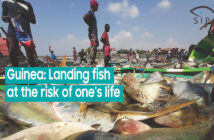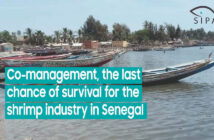After almost six years of implementation, the “Mitao Forecast”, an early warning system in the maritime zone, enables fishermen to improve their safety at sea, sustainable and responsible stock management has begun to prevail in villages and good income management is being adopted by fishermen’s households. The resilience of fishing communities is being enhanced in the face of current climate change.
Madagascar’s southern coastline stretches for about 250km. This area includes 13 coastal communes as part of the Androy and Anosy Regions. The far south of Madagascar, the area between the Mandrare River in the east and the Menarandra River in the west, is known as home to a rich marine biodiversity: crustaceans, molluscs, fish, algae and many others.
According to data received from the Androy Regional Fisheries and Aquaculture Service, lobster production in the area in 2016 was estimated at 30 tonnes worth approximately $198,000. In his thesis, which he defended in 2016, Mahatanty Tsimanaoraty Paubert, an expert in fisheries and climate change, explains that the average catch per unit effort (CPUE) of fishermen for fish is between 5kg and 80kg per boat daily depending on the season or wind speed and sea conditions. The fishing effort is estimated at between 150 and 160 days of fishing per year.
The poor weather due to the dominance of the south wind called “Tiok’atimo” and the “Beach rock” that fringes the coast are the main challenges to production.
The Tiok’atimo is a permanent lethal hazard to fishermen.
The prevailing “Tiok’atimo” wind which should normally occur between May and November has been almost permanent for several years now, and fishermen have had accidents, some of them fatal. In 2005, in Soamagnitse, a rural commune of Tragnovaho, district of Beloha in the Androy region, 71 fishermen lost their lives according to statistics received from Chief Fokontany. In the same village, 31 went missing in 2010; many boats were also broken by the “Beach rock” during embarking or landing, sometimes forcing some fishermen to give up their profession, as Florentine, a fisherman’s wife, reported: “When my husband arrived in the village, we realized that the boat had been broken, knowing that a “lakambezo” [light boat with outriggers]costs $158, and we don’t have the money to buy it. When you look at the fishing net, one of which costs $3, if you come to lose it, there will be no more income and the only thing left to do is stay at home”.
Watching the skyline was the fishermen’s solution before the “Mitao Forecast”.
In the past, fishermen tried to predict the weather by observing the clouds, the stars and the wind before deciding whether to go out to sea or not, but this technique is becoming obsolete in the face of climate change.

From 2014 to 2015, the “Mitao Forecast” was installed for the first time in the district of Bazary-Kely near the Libanona beach and in the district of Ambinanibe; both places are located in the urban commune of Taolagnaro. Sainte Luce, a rural commune a little far from the city, still in the Anosy region, followed suit with the installation, carried out with the support of a major local mining operator. In 2014, a patent was granted for this system.
Toky Sylvestre and Mahatante Tsimanaoraty Paubert are the initiators of this system. “Following the fatal accidents, we had to find a solution to avoid or reduce the number of accidents,” says Paubert. Like many other fishermen’s families, Toky Sylvestre also lost some members of his family. This prompted him to find a solution to reduce the number of deaths at sea. After 5 years of research, from 2009 to 2014, Toky Sylvestre and his colleague Mahatante Tsimanaoraty Paubert finally came up with an early warning system called “Mitao Forecast”. To break it down, the Mitao in the local language translates into French as “prudence” and the English word forecast is translated into French as “prévision”. This system is an agro-meteorological panel made up of a table with green, yellow, orange and red pieces showing the intensity of the wind on the Beaufort scale [a scale for measuring average wind speed in maritime environments]. The system also comes with other pieces showing wind direction and wave height.
Toky Sylvestre argues that the system helps fishing communities to know the weather four (4) days in advance. “We had to go through 2 seasonal cycles, almost 2 years to test the system” explains Paubert.
How does the system work?
Toky Sylvestre lives in Taolagnaro. He is the Executive Director of the NGO Aquatic Service which he created in 2012. This NGO is involved in managing the information to be sent by mobile message to the focal points who are in charge of transposing the information received into the table. “The meteorological data obtained on the Internet are interpreted on the Beaufort scale, converted into a colour code corresponding to wind speed and strength according to the weather forecast, which are then used to predict the weather for a day, one half in the morning and the whole afternoon” says Toky Sylvestre.

Toky Sylvestre adds that the “Mitao Forecast” is designed to inform fishermen about the weather before they go out to sea. A four (4) day forecast is indicated; certain information are displayed, such as wind direction and colour codes indicating wind strength and speed. The green colour indicates that the sea will be calm from 0 to 5k/h; the yellow colour from 6 to 19k/h; the orange colour from 19 to 28k/h. The red colour indicates more than 28km and more per hour; starting from the orange colour, fishermen should not venture far; the red colour in prevention means that small boats with or without engine should not go out to sea anymore.
What impacts hitherto?
Since the installation of “Mitao Forecast” in fishing villages, fatal accidents have been reduced by 98% according to Toky Sylvestre. Salohy DEWA, Interregional Director of Meteorology for the Anosy and Androy region notes that “the death rate of fishermen at sea has decreased”. She continues: “Initially, we were a little concerned. How could we turn the information from the engineers into something easier for the beneficiaries to read? This is the most suitable technique, it’s easy even for people in the countryside to use colour coding.
Florentine, a fisherman’s wife, confirms: “With the red colour, we already know there is potential death, so we stay in the village”. Informed fishermen manage their activities well, especially their trips to the sea. François is a fisherman from Ambinanibe in Taolagnaro. He is the Chair of the fishing community. He is also one of the focal points in this locality. He testifies that “Before Mitao came about, we would sail with uncertainty; many of us would get caught by a storm and die. Some had gone missing and never returned. After the Mitao Forecast was set up in our village, the fishermen began to pay heed. Aquatic Service sent a message that will be passed on to them. Even the women are also informing themselves and as everyone knows the weather, no injuries have been reported; everyone is warned about the weather ahead of time”.
As a result, fishermen only go out during the safe period for maximum productivity. Feno Martin, Chair of the fishing community in Tragnovaho, Beloha, in the Androy region explains: “Thanks to the knowledge of the weather, we can go fishing further and get a lot of products to provide for our family, and earn much more money”. Besides, fishermen’s families like Rasoanantenaina Eléonore’s can manage the family income. Her family lives in Ambinanibe Taolagnaro in the Anosy region. She claims that the family’s financial management has improved since the panel has been installed in their village, adding: “We know ahead of time if it would be bad for two (2) days, the following day, or for the next four (4) days; as soon as our husband earns money, we save up for the two or three bad weather conditions according to the weather forecast”.
Starting in 2014, 40 systems have been installed by June, 2020 in three (3) regions in the south of the island including Atsimo Andrefana, Anosy and Androy. To cover the southern coast alone, from the district of Morombe to that of Taolagnaro, roughly 200 panels remain to be installed, one panel for one (1) fishing village. The cost for installing a single panel is estimated at $528. Toky Sylvestre explains that according to Mahatante Tsimanaoraty Paubert the budget to cover the entire southern coast is estimated at $105,600 in total, excluding preliminary studies, materials to be purchased, and the various costs necessary for installation.
Noro RAOELIHARISON




